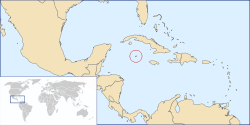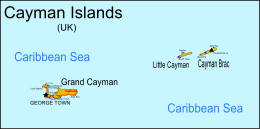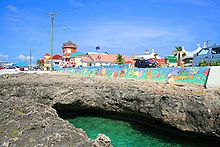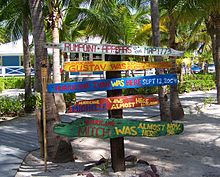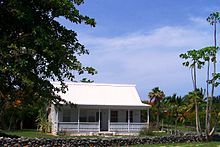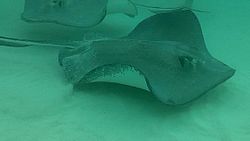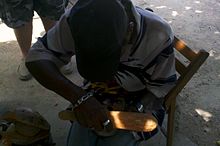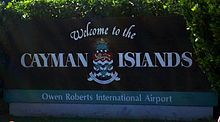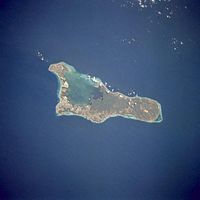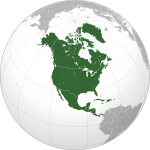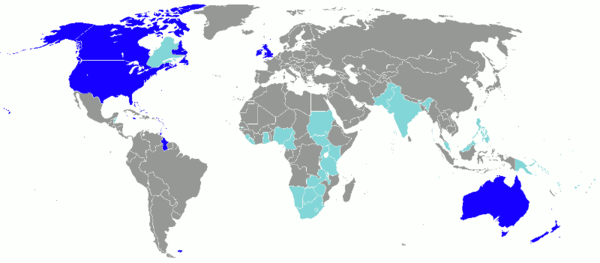- Cayman Islands
-
Cayman Islands 

Flag Coat of arms Motto: "He hath founded it upon the seas" Anthem: God Save the Queen (official)
National Song: "Beloved Isle Cayman"Capital
(and largest city)George Town
19°20′N 81°24′W / 19.333°N 81.4°WEthnic groups 40% Afro-European, 20% European, 20% African, 20% other[1] Demonym Caymanian Government British Overseas Territory - Monarch Queen Elizabeth II - Governor Duncan Taylor - Premier McKeeva Bush Legislature Legislative Assembly Establishment - British Overseas Territory 1962 - Current Constitution 6 November 2009 Area - Total 264 km2 (206th)
102 sq mi- Water (%) 1.6 Population - 2010 census estimate 54,878 (209th) - Density 212[2]/km2 (57th)
549/sq miGDP (PPP) 2008 estimate - Total $2.25 billion - Per capita $43,800 GDP (nominal) 2010 estimate - Total $2.25 billion (158th) - Per capita $47,000 (10th) HDI (2003) n/a (NA) (unranked) Currency Cayman Islands dollar ( KYD)Time zone (UTC-5) - Summer (DST) not observed (UTC-5) Drives on the left Internet TLD .ky Calling code +1-345 The Cayman Islands (
 /ˈkeɪmən/ or /keɪˈmæn/) is a British Overseas Territory and overseas territory of the European Union located in the western Caribbean Sea. The territory comprises the three islands of Grand Cayman, Cayman Brac, and Little Cayman, located south of Cuba and northwest of Jamaica. The Cayman Islands are considered to be part of the geographic Western Caribbean Zone as well as the Greater Antilles. The territory is a major world offshore financial centre.[3]
/ˈkeɪmən/ or /keɪˈmæn/) is a British Overseas Territory and overseas territory of the European Union located in the western Caribbean Sea. The territory comprises the three islands of Grand Cayman, Cayman Brac, and Little Cayman, located south of Cuba and northwest of Jamaica. The Cayman Islands are considered to be part of the geographic Western Caribbean Zone as well as the Greater Antilles. The territory is a major world offshore financial centre.[3]Contents
History
The Cayman Islands were first logged as sighted by Christopher Columbus on 10 May 1503 during his fourth and final voyage to the New World. He named the islands Las Tortugas after the large number of sea turtles observed there. The first recorded English visitor to the islands was Sir Francis Drake in 1586. He subsequently named the islands "Cayman" after caiman, a Neo-Taino word for "alligator".
The Cayman Islands remained largely uninhabited until the 17th century. While there is no archaeological evidence for an indigenous people on the islands, a variety of settlers from various backgrounds made their home on the islands, including pirates, refugees from the Spanish Inquisition, shipwrecked sailors, and deserters from Oliver Cromwell's army in Jamaica.
The first recorded permanent inhabitant of the Cayman Islands, Isaac Bodden, was born on Grand Cayman around 1661. He was the grandson of the original settler named Bodden who was probably one of Oliver Cromwell's soldiers at the taking of Jamaica in 1655.[citation needed]
England took formal control of the Cayman Islands, along with Jamaica, under the Treaty of Madrid in 1670. Following several unsuccessful attempts at settlement, a permanent English-speaking population in the islands dates from the 1730s. With settlement, after the first royal land grant proscribed by the Governor of Jamaica in 1734, came the perceived need for slaves.[4] Many were brought to the islands from Africa; this is evident today with the majority of native Caymanians being of African and English descent. The results of the first census taken in the islands in 1802 showed the population on Grand Cayman to be 933 with 545 of those inhabitants being slaves. Slavery was abolished in the Cayman Islands in 1834. At the time of abolition, there were over 950 slaves owned by 116 Caymanian families.
The islands continued to be governed as a single colony with Jamaica until 1962 when they became a separate Crown colony while Jamaica became an independent Commonwealth realm.
The Cayman Islands historically have been a tax-exempt destination. On 8 February 1794, the Caymanians rescued the crews of a group of ten merchant ships, including HMS Convert, an incident that has since become known as the Wreck of the Ten Sail. The ships had struck a reef and run aground during rough seas. Legend has it that King George III rewarded the island with a promise never to introduce taxes as compensation for their generosity as one of the ships carried a member of the King's own family, his son Prince William. While this remains a popular legend, Queen Elizabeth II herself, along with various history books, state the story is not true.[5]
The island of Grand Cayman, which lies largely unprotected at sea level, was hit by Hurricane Ivan on 11–12 September 2004. Ivan's storm surge completely over-washed Grand Cayman, and an estimated 95% of the buildings on the island were either damaged or destroyed.[6][not in citation given (See discussion.)] Power, water and communications were disrupted in some areas for months as Ivan was the worst hurricane to hit the islands in 87 years.[citation needed] Grand Cayman began a major rebuilding process and within two years, its infrastructure was nearly[weasel words] returned to pre-hurricane status. Due to the tropical location of the islands, more hurricane or tropical systems have affected the Cayman Islands than any other region in the Atlantic basin; it has been brushed or directly hit, on average, every 2.23 years.[7]
Geography
The Cayman Islands are located in the western Caribbean Sea and are the peaks of a massive underwater ridge, known as the Cayman Ridge (or Cayman Rise). This ridge flanks the Cayman Trough, 6,000 m (20,000 ft) deep [8] which lies 6 km (3.7 mi) to the south.[9] The islands lie in the northwest of the Caribbean Sea, south of Cuba and west of Jamaica. They are situated about 700 km (430 mi) south of Miami, [10] 366 km (227 mi) south of Cuba, [11] and about 500 km (310 mi) northwest of Jamaica.[12] Grand Cayman is by far the biggest, with an area of 197 km2 (76 sq mi).[13] The two "Sister Islands" of Cayman Brac and Little Cayman are located about 120 km (75 mi) east north-east of Grand Cayman and have areas of 38 and 28.5 km2 (15 and 11.0 sq mi)[14] respectively.
All three islands were formed by large coral heads covering submerged ice age peaks of western extensions of the Cuban Sierra Maestra range and are mostly flat. One notable exception to this is The Bluff on Cayman Brac's eastern part, which rises to 43 m (141 ft) above sea level, the highest point on the islands. [15]Terrain is mostly a low-lying limestone base surrounded by coral reefs.
Fauna
Further information: List of mammals of the Cayman IslandsThere are ten mammalian species in the islands. Cayman avian fauna includes two endemic subspecies of Amazona parrots: Amazona leucocephala hesterna, or Cayman Brac Parrot, native only to Cayman Brac, and Amazona leucocephala caymanensis or Grand Cayman Parrot, which is native to the Cayman Islands, forested areas of Cuba, and the Isla de la Juventud.
Among other notable fauna is the critically endangered Blue Iguana, which is endemic to Grand Cayman.[16] Also present are the Central American agouti, along with the Booby Birds on Cayman Brac.[17]
Climate
Main article: Climate of the Cayman IslandsThe Cayman Islands have a tropical marine climate, with a wet season of warm, rainy summers (May to October) and a dry season of relatively cool winters (November to April).[citation needed]
A major natural hazard is the tropical cyclones that form during the Atlantic hurricane season from July to November.
Demographics
The Cayman Islands have more registered businesses than they have people.[18] The latest population estimate of the Cayman Islands is about 55,700 as of 2009, representing a mix of more than 100 nationalities. Out of that number, about half are of Caymanian descent. About 60% of the population is of mixed race (mostly mixed African-European). The islands are almost exclusively Christian, with large numbers of Presbyterians and Catholics. The vast majority of the population resides on Grand Cayman, followed by Cayman Brac and Little Cayman, respectively.[19]
The capital of the Cayman Islands is George Town, which is located on the southwest coast of Grand Cayman.
Population of the districts
According to the Cayman Islands 2010 census the estimated resident population is 54,878 people,[20] broken down as follows:
- George Town: 35,600
- West Bay: 11,269
- Bodden Town: 10,341
- North Side: 1,437
- East End: 1,369
- Cayman Brac and Little Cayman (Sister Islands): 2,277
Economy
With an average income of around KYD$47,000, Caymanians have the highest standard of living in the Caribbean. According to the CIA World Factbook, the Cayman Islands GDP per capita is the 14th highest in the world.[21] The islands print their own currency, the Cayman Islands Dollar (KYD), which is pegged to the U.S. dollar at a fixed rate of 1 KYD = 1.20 USD.[22]
The government's primary source of income is indirect taxation: there is no income tax, capital gains tax, or corporation tax. An import duty of 5% to 22% (Automobiles 29.5% to 100%) is levied against goods imported into the islands. Few goods are exempt; notable examples include books, cameras, and infant formula.[citation needed]
Tourism
One of Grand Cayman's main attractions is Seven Mile Beach, on which a number of the island's hotels and resorts are located. Historical sites in GCM, such as Pedro St. James Castle in BoddenTown, also attract visitors. Tourists also visit the Sister Islands, Little Cayman[23] and Cayman Brac.[24]
All three islands offer scuba diving, and the Cayman Islands are home to several snorkeling locations, where tourists can swim with stingrays. The most popular area to do this is Stingray City, Grand Cayman.
There are two shipwrecks off the shores of Cayman Brac, including the MV Keith Tibbetts;[citation needed] Grand Cayman has several shipwrecks off its shores. The USS Kittiwake was decommissioned on 30 September 1994 and struck from the Naval Vessel Register on the same day. Her title was transferred in November 2008 for an undisclosed amount to the government of the Cayman Islands. The Cayman Islands government intended to use Kittiwake to form a new artificial reef. Originally intended to be sunk in June 2009, she was finally sunk off Seven Mile Beach, Grand Cayman on 5 January 2011.
Other Grand Cayman tourist attractions include the Ironshore landscape of Hell, the 23-acre (93,000 m2) marine theme park Boatswain's Beach, also home of the Cayman Turtle Farm, the production of gourmet sea salt, and the Mastic Trail, a hiking trail through the forests in the centre of the island. The NationalTrust for the Cayman Islands provides guided tours weekly on the Mastic Trail and other locations.[25]
.
Points of interest include the East End Light (sometimes called Gorling Bluff Light) is a lighthouse located at the east end of Grand Cayman island in the Cayman Islands. The lighthouse is the centerpiece of East End Lighthouse Park, managed by the National Trust for the Cayman Islands; the first navigational aid on the site was the first lighthouse in the Cayman Islands.
Shipping
The merchant marine total is 123 ships (1,000 GRT or over) totaling 2,402,058 GRT/3,792,094 metric tons deadweight (DWT) ships by type: bulk 22, cargo 5, chemical tanker 31, container 2, liquefied gas 1, petroleum tanker 21, refrigerated cargo 35, roll on/roll off 5, specialized tanker 1 note: some foreign ships register in the Cayman Islands as a flag of convenience; includes ships from 11 countries among which are: Greece 15, US 5, UK 5, Cyprus 2, Denmark 2, Norway 3 (2002 est.).
Financial services industry
The Cayman Islands are a major international financial centre. The biggest sectors are "banking, hedge fund formation and investment, structured finance and securitization, captive insurance, and general corporate activities."[26] Regulation and supervision of the financial services industry is the responsibility of the Cayman Islands Monetary Authority (CIMA).
The Cayman Islands are the fifth-largest banking centre in the world,[27] with $1.5 trillion in banking liabilities.[26] There are 279 banks (as of June 2008[update]), 19 of which are licensed to conduct banking activities with domestic (Cayman-based) and international clients, the remaining 260 are licensed to operate on an international basis with only limited domestic activity. Financial services generated CI$1.2 billion of GDP in 2007 (55% of the total economy), 36% of all employment and 40% of all government revenue. In 2010, the country ranked fifth internationally in terms of value of liabilities booked in the Cayman Islands and sixth in terms of assets booked. It has branches of 40 of the world's 50 largest banks. The Cayman Islands are the second largest captive domicile in the world with more than 700 captives, writing more than US$7.7 billion of premiums and with US$36.8 billion of assets under management.[28]
There are a number of service providers. These include global financial institutions including HSBC, UBS, and Goldman Sachs; over 80 administrators, leading accountancy practices (incl. the Big Four auditors), and offshore law practices including Maples & Calder.[29]
Since the introduction of the Mutual Funds Law in 1993, which has been copied by jurisdictions around the world, the Cayman Islands have grown to be the world's leading offshore hedge fund jurisdiction.[29] In June 2008, it passed 10,000 hedge fund registrations, and over the year ending June 2008 CIMA reported a net growth rate of 12% for hedge funds.[30]
Starting in the mid-late 1990s, offshore financial centres, such as the Cayman Islands, came under increasing pressure from the OECD for their allegedly harmful tax regimes, where the OECD wished to prevent low-tax regimes from having an advantage in the global marketplace. The OECD threatened to place the Cayman Islands and other financial centres on a "black list" and impose sanctions against them.[31] However, the Cayman Islands successfully avoided being placed on the OECD black list in 2000 by committing to regulatory reform to improve transparency and begin information exchange with OECD member countries about their citizens.[31]
In 2004, under pressure from the UK, the Cayman Islands agreed in principle to implement the European Union Savings Directive (EUSD), but only after securing some important benefits for the financial services industry in the Cayman Islands. As the Cayman Islands are not subject to EU laws, the implementation of the EUSD is by way of bilateral agreements between each EU member state and the Cayman Islands. The government of the Cayman Islands agreed on a model agreement, which set out how the EUSD would be implemented with the Cayman Islands.[32]
A report published by the International Monetary Fund (IMF), in March 2005, assessing supervision and regulation in the Cayman Islands' banking, insurance and securities industries, as well as its money laundering regime, recognised the jurisdiction's comprehensive regulatory and compliance frameworks. "An extensive program of legislative, rule and guideline development has introduced an increasingly effective system of regulation, both formalizing earlier practices and introducing enhanced procedures", noted IMF assessors. The report further stated that "the supervisory system benefits from a well-developed banking infrastructure with an internationally experienced and qualified workforce as well as experienced lawyers, accountants and auditors", adding that, "the overall compliance culture within Cayman is very strong, including the compliance culture related to AML (anti-money laundering) obligations".[33]
On 4 May 2009, United States President Barack Obama declared his intentions to curb the use of financial centres by multinational corporations. In his speech, he singled out the Cayman Islands as a tax shelter.[34]
The next day, the Cayman Island Financial Services Association submitted an open letter to the President detailing The Cayman Islands' role in international finance and its value to the US financial system.[35]
Labour
The Cayman Islands has a small population and therefore a limited work force. Work permits may therefore be granted to foreigners. On average, there have been more than 21,000 foreigners holding valid Work Permits.[36]
Work permits for non-citizens
In order to work in the Cayman Islands as a non-citizen, a work permit is required. This involves passing a police background check and a health check. A prospective immigrant worker will not be granted a permit unless certain medical conditions are present which include testing negative for syphilis or HIV. A permit may be granted to individuals on special work.
A foreigner must first have a job in order to move to the Cayman Islands. The employer applies and pays for the work permit.[37] Work permits are not granted to foreigners who are in the Cayman Islands (unless it is a renewal). The Cayman Islands Immigration Department requires foreigners to remain out of the country until their work permit has been approved.[38]
The Cayman Islands presently imposes a controversial "rollover" in relation to expatriate workers who require a work permit. Non-Caymanians are only permitted to reside and work within the territory for a maximum of seven years unless they satisfy the criteria of key employees. Non-Caymanians who are 'rolled over' may return to work additional 7 year periods subject to a 1 year gap between their periods of work. The policy has been the subject of some controversy within the press. Law firms have been particularly upset by the recruitment difficulties that it has caused.[39] Other less well remunerated employment sectors have been affected as well. Concerns about safety have been expressed by diving instructors and realtors have also expressed concerns. Others support the rollover as necessary to protect Caymanian identity in the face of large immigration of expatriate workers.[40]
Concerns have been expressed that in the long term, the policy may damage the preeminence of the Cayman Islands as an offshore financial centre by making it difficult to recruit and retain experienced staff from onshore financial centres. Government employees are no longer exempt from this "rollover" policy according to this report in a local newspaper.[41] The governor has used his constitutional powers, which give him absolute control for the disposition of civil service employees to determine which expatriate civil servants are dismissed after seven years service and which are not.[citation needed]
This policy is incorporated in the Immigration Law (2003 revision), written by the United Democratic Party government, and subsequently enforced by the People's Progressive Movement Party government. Both governments agree to the term limits on foreign workers, and the majority of Caymanians also agree it is necessary to protect local culture and heritage from being eroded by a large number of foreigners gaining residency and citizenship.[42]
Government
The Cayman Islands are a British overseas territory, listed by the UN Special Committee of 24 as one of the last non-self governing territories. A 15-seat Legislative Assembly is elected by the people every four years to handle domestic affairs. Of the elected Members of the Legislative Assembly (MLAs), five are chosen to serve as government ministers in a Cabinet headed by the Governor. The head of government is the Premier.[citation needed]
A Governor is appointed by the British Government to represent the monarch. Governors can exercise complete executive authority if they wish through blanket powers reserved to them in the constitution. They must give Royal Assent to all legislation, which allows them the power to strike down any law the legislature may see fit for the country. In modern times, the Governor usually allows the country to be run by the Cabinet, and the civil service to be run by the Deputy Governor, who is the Acting Governor when the Governor is not able to discharge his usual duties for one reason or another. The current Governor of the Cayman Islands is Duncan Taylor and the current Deputy Governor is The Honourable Donovan Ebanks.
The Cabinet is composed of two official members and five elected members, called ministers; one of whom is designated Premier.
The official members are the Deputy Governor and the Attorney General. They are appointed by the governor in accordance with Her Majesty's instructions, and although they have seats in the Legislative Assembly, under the 2009 Constitution, they do not vote.
The five ministers are voted into office by the 15 elected members of the Legislative Assembly of the Cayman Islands. One of the ministers, the leader of the majority political party, is appointed premier by the governor.
After consulting the premier, the governor allocates a portfolio of responsibilities to each Cabinet member. Under the principle of collective responsibility, all ministers are obliged to support in the Assembly any measures approved by Cabinet.
Almost 80 departments, sections and units carry out the business of government, joined by a number of statutory boards and authorities set up for specific purposes, such as the Port Authority, the Civil Aviation Authority, the Immigration Board, the Water Authority, the University College Board of Governors, the National Pensions Board, and the Health Insurance Commission.
The defence of the Cayman Islands is the responsibility of the United Kingdom. The Royal Cayman Islands Police Service provides police services in the country. The Cayman Islands Cadet Corps was formed in March 2001.[citation needed]
Since 2000, there have been two official major political parties: United Democratic Party (UDP) and the People's Progressive Movement (PPM). While there has been a shift to political parties, many contending for an office still run as independents.
Taxation
No direct taxation is imposed on residents and Cayman Islands companies. The government receives the majority of its income from indirect taxation. Duty is levied against most imported goods, which is typically in the range of 22% to 25%. Some items are exempted, such as baby formula, books, cameras and certain items are taxed at 5%. Duty on automobiles depends on their value. The duty can amount to 29.5% up to $20,000.00 KYD CIF and up to 42% over $30,000.00 KYD CIF for expensive models. The government charges flat licensing fees on financial institutions that operate in the islands and there are work permit fees on foreign labour. A 10% government tax is placed on all tourist accommodations in addition to US$25.00 departure tax each tourist pays upon leaving the island.[43]
There are no taxes on profits, capital gains, income or any withholding taxes charged to foreign investors. There are no estate or death duties payable on Cayman Islands real estate or other assets held in the Cayman Islands.[citation needed]
Foreign relations
Foreign policy is controlled by the United Kingdom, as the islands remain an overseas territory of the United Kingdom. Although in its early days, the Cayman Islands' most important relationships were with Britain and Jamaica, in recent years, as a result of economic dependence, a relationship with the United States has developed.
Though the Cayman Islands are involved in no major international disputes, they have come under some criticism due to the use of their territory for narcotics trafficking and money laundering. In an attempt to address this, the government entered into the Narcotics Agreement of 1984 and the Mutual Legal Assistance Treaty of 1986 with the United States, in order to reduce the use of their facilities associated with these activities. In more recent years, they have stepped up the fight against money laundering, by limiting banking secrecy, introducing requirements for customer identification and record keeping, and requiring banks to cooperate with foreign investigators.
Due to their status as an overseas territory of the UK, the Cayman Islands have no representation either in the United Nations or in most other international organizations. However, the Cayman Islands still participates in some international organizations, being an associate member of Caricom and UNESCO, and a member of a sub-bureau of Interpol.[citation needed]
The defence and internal security of the Cayman Islands is the responsibility of the United Kingdom.
Infrastructure
Ports
Ports and harbours include Cayman Brac, and George Town.
Air transport
There are three airports in the Cayman Islands, one for each island.
Grand Cayman is served by Owen Roberts International Airport. Cayman Brac is served by Gerrard Smith International Airport and Little Cayman is served by Edward Bodden Airfield.
Cayman Airways is the national flag carrier of the Cayman Islands. With its official headquarters in Grand Cayman, it operates mainly as an international and domestic scheduled passenger carrier, with cargo services available on all routes. It also has a limited charter service offered. Its operations are based at Owen Roberts International Airport, Grand Cayman.
Island Air is a small airline in the Cayman Islands providing services between Grand Cayman, Cayman Brac, and Little Cayman.
Communications
Education
Primary and secondary schools
The Cayman Islands Education Department operates state schools. Caymanian children are entitled to free primary and secondary education. Various churches and private foundations operate several private schools.
Colleges and universities
The University College of the Cayman Islands has campuses located on Grand Cayman and Cayman Brac and is the only government run university on the Cayman Islands.[44] The International College of the Cayman Islands is a private college and is located in Grand Cayman. The college was established in 1970 and offers Associate's, Bachelor's and Master's degree programmes.[45] Grand Cayman is also home to St. Matthew's University, which includes a medical school and a school of veterinary medicine.[46] The Cayman Islands Law School, a branch of the University of Liverpool, is based on Grand Cayman.[47]
The Cayman Islands Civil Service College, a unit of Cayman Islands government organised under the Portfolio of the Civil Service, is located in Grand Cayman. Co-situated with University College of the Cayman Islands, it offers both degree programs and continuing education units of various sorts. The college opened in 2007 and is also used as a government research centre.
Health and public safety
Healthcare
There are four hospitals in the Cayman Islands. Grand Cayman is home to Chrissie Tomlinson Memorial Hospital, Cayman Islands Hospital and George Town Hospital; Faith Hospital is located on Cayman Brac.[48]
In 2007, an MRI unit was installed at the Chrissie Tomlinson Memorial Hospital, replacing the one destroyed by Hurricane Ivan in 2004. In 2009, a stand-alone Open MRI facility was opened. This centre provides MRI, CT, X-Ray and DEXA (Bone density) scanning. Also housed in this building is the Heart Health Centre, which provides Ultrasound, Nuclear Medicine, Echocardiography and Cardiac Stress Testing.[49]
For divers and others in need of hyperbaric oxygen therapy, there is a two-person recompression chamber at the Cayman Islands Hospital on Grand Cayman, run by Cayman Hyperbaric Services. Hyperbaric Services has also built a hyperbaric unit at Faith Hospital in Cayman Brac.[citation needed]
Police and fire
The Royal Cayman Islands Police Service (RCIP) provides law enforcement for the three islands. Regular off-shore marine patrols are conducted by the RCIP and Grand Cayman is a port of call for the United States Coast Guard. The Cayman Islands Fire Service provides fire prevention, fire fighting, and emergency medical rescue by land and air.[50] Department headquarters are located in George Town and has substations located in Frank Sound, West Bay, Cayman Brac and Little Cayman.[51]
Sports
Truman Bodden Sports Complex is a multi-use complex in George Town. The complex is separated into an outdoor, six-lane 25-metre (82 ft) swimming pool, full purpose track and field and basketball/netball courts. The field surrounded by the track is used for football matches as well as other field sports. The track stadium holds 10,000 people.
Association football is the national and most popular sport.[citation needed] Rugby is a developing sport, and has its own national men's team, women's team, and Sevens team. The Cayman Islands Under 20 rugby team has also qualified for the JWRT in Kenya 2009.[citation needed]
The Cayman Islands are members of FIFA, the International Olympic Committee and the Pan American Sports Organisation, and also compete in the biannual Island Games.[citation needed]
The Cayman Islands are members of the International Cricket Council which they joined in 1997 as an Affiliate, before coming an Associate member in 2002. The Cayman Islands national cricket team represents the islands in international cricket. The team has previously played the sport at first-class, List A and Twenty20 level. It competes in Division Five of the World Cricket League.[52]
Flag football (CIFFA) has men's, women's and co-ed leagues.
Other organised sports leagues include softball, beach volleyball, Gaelic football, and ultimate frisbee.
The Cayman Islands Olympic Committee was founded in 1973 and was recognized by the IOC (International Olympic Committee) in 1976.
In the 21st century, skateboarding has become popular among the youth.
In February 2010, the first purpose built track for kart racing in the Cayman Islands was opened.[53] Corporate karting Leagues at the track have involved widespread participation with 20 local companies and 227 drivers taking part in the 2010 Summer Corporate Karting League.[54]
Music
The Cayman National Cultural Foundation manages the F.J. Harquail Cultural Centre and the US$4 million Harquail Theatre. The Cayman National Cultural Foundation, established in 1984, helps to preserve and promote Cayman folk music, including the organization of festivals such as Cayman Islands International Storytelling Festival, the Cayman JazzFest, Seafarers Festival and Cayfest.[citation needed]
Media
There are three newspapers currently in circulation throughout the islands: the Cayman Compass, Cayman Net News and iNews Cayman. An online newspaper, Cayman News Service, features Cayman Islands news. A local television station, CITN - Cayman 27, shows Cayman Islands news. Sixteen local radio stations are broadcasted throughout the islands.
Feature films that have been filmed in the Cayman Islands include: The Firm, Haven, Cayman Went [55] and Zombie Driftwood.[56]
Notable Caymanians
- Gladwyn K. Bush, Folk Artist
- McKeeva Bush, Politician, Premier of the Cayman Islands
- Kurt Tibbetts, Politician
- Selita Ebanks Fashion model
- Frank E. Flowers Independent filmmaker, film director and screenwriter
- Ronald Forbes Olympic athlete
- Brett Fraser Olympic athlete
- Shaune Fraser Olympic athlete
- Jason Gilbert Record producer and songwriter
- Cydonie Mothersille Track and field gold medal athlete
- Lee Ramoon Footballer
- Kareem Streete-Thompson Olympic athlete
- Tanya Streeter, Hall-of-Fame Free-Diver
- Dow Travers Olympic athlete
- Edison Mclean, 1st Caymanian gold medalist in Olympic Skeet, Island Games.
See also
- Outline of the Cayman Islands
- Index of Cayman Islands-related articles
- British Overseas Territories
- Roman Catholic Mission Sui Iuris of Cayman Islands
Notes
- ^ "Background Note: Cayman Islands". State.gov. 2011-02-18. http://www.state.gov/r/pa/ei/bgn/5286.htm. Retrieved 2011-07-31.
- ^ "Commonwealth Secretariat - Cayman Islands". Thecommonwealth.org. http://www.thecommonwealth.org/YearbookInternal/140416/140424/cayman_islands/. Retrieved 2011-07-31.
- ^ "Tax me if you can. Haven or Havoc?". http://www.pbs.org/wgbh/pages/frontline/shows/tax/schemes/cayman.html.
- ^ "Cayman Islands History". Gocayman.ky. http://www.gocayman.ky/history.html. Retrieved 2011-07-31.
- ^ Zayas 1914
- ^ U.S. National Hurricane Center (October 2010). "Hurricane History". NOAA. http://www.nhc.noaa.gov/HAW2/english/history.shtml.[dead link]
- ^ "Grand Cayman's history with tropical systems". Hurricanecity.com. http://www.hurricanecity.com/city/caymanislands.htm. Retrieved 2011-07-31.
- ^ Cayman Islands, World Resources Institute
- ^ Phillippe G. Bush, Grand Cayman, British West Indies, UNESCO Coastal region and small island papers 3
- ^ "Coordinates + total distance". web page. mapcrow. http://www.mapcrow.info/Distance_between_Cayman_Islands_CJ_and_Miami_US.html. Retrieved 23 October 2011.
- ^ "Distance from Cayman Islands to Cuba". web page. distancefromto.net/. 2011. http://www.distancefromto.net/distance-from/Cayman+Islands/to/Cuba. Retrieved 23 October 2011.
- ^ "Coordinates and total distance". web page. Mapcrow. http://www.mapcrow.info/Distance_between_Kingston_JM_and_George_Town_CJ.html. Retrieved 23 October 2011.
- ^ http://www.unesco.org/csi/pub/papers/bush.htm
- ^ Glenn Gerber. "Lesser Caymans iguana Cyclura nubila caymanensis". web page. The World Conservation Union. http://www.iucn-isg.org/actionplan/ch2/lessercaymans.php. Retrieved 23 October 2011.
- ^ "World Atlas Highest and Lowest points". web page. Graphic Maps. http://www.worldatlas.com/aatlas/infopage/highlow.htm. Retrieved 23 October 2011.
- ^ Kenyon, Georgina (2005-09-17). "Pulling the blue iguana from the brink". New Scientist (Simone Coless) (2517): 42–43. http://www.newscientist.com/channel/life/mg18725172.400.
- ^ Woods, C. A. and C. W. Kilpatrick. 2005. Hystricognathi. pp 1538–1600 in Mammal Species of the World a Taxonomic and Geographic Reference 3rd ed. D. E. Wilson and D. M. Reeder eds. Smithsonian Institution Press, Washington D.C.
- ^ "Regions and territories: Cayman Islands". BBC News. 2011-04-29. http://news.bbc.co.uk/1/hi/world/americas/country_profiles/3709816.stm. Retrieved 2011-07-31.
- ^ "CIA - The World Factbook - Cayman Islands". https://www.cia.gov/library/publications/the-world-factbook/geos/cj.html. Retrieved 2008-06-23.
- ^ "The Cayman Islands 2010 Population and Housing Census: Preliminary Report". Economics and Statistics Office. 7 February 2011. http://caymannewsservice.com/sites/default/files/Preliminary%202010%20Census%20Report%20FINAL.pdf. Retrieved 2 June 2011.
- ^ "CIA - The World Factbook - Rank Order - GDP - per capita (PPP)". https://www.cia.gov/library/publications/the-world-factbook/rankorder/2004rank.html. Retrieved 2008-06-23.
- ^ Cayman Islands Monetary Authority
- ^ "This week's dream: diving and lazing on Little Cayman", (29 November 2008) The Week p. 39, Dennis Publishers, UK
- ^ Harper, Skip (2001). Adventuring in Cayman Brac. Fort Collins, Colorado, USA: Head and Toe Publishers. ISBN 978-0-964-06452-2.
- ^ "National Trust For the Cayman islands". Nationaltrust.org.ky. http://www.nationaltrust.org.ky. Retrieved 2011-07-31.
- ^ a b United States Government Accountability Office (2008). GAO Report to the Chairman and Ranking Member, Committee on Finance, U.S. Senate, p. 7.
- ^ Places in the sun. (2007, 24 February). The Economist, no. 382 (8517 suppl.), 3-5.
- ^ Cayman Islands Monetary Authority (11 July 2008), Regulatory Framework: Statistics[dead link]. Retrieved 25 July 2008 from:
- ^ a b Bringing Cayman's Mutual Funds Law up to speed (1 October 2005). Hedge Week.
- ^ "10,000–plus funds registered in CI". Caycompass.com. 2008-07-29. http://www.caycompass.com/cgi-bin/CFPnews.cgi?ID=1032423. Retrieved 2011-07-31.
- ^ a b "Haven or havoc?". Pbs.org. http://www.pbs.org/wgbh/pages/frontline/shows/tax/schemes/cayman.html. Retrieved 2011-07-31.
- ^ "Guide to the EU Savings Directive" (PDF). http://www.ask.bm/uploaded/Publication/641_File_5.pdf. Retrieved 2011-07-31.
- ^ International Cooperation
- ^ The Crave (2010-10-22). "Transcript: Obama Preaches Against Tax Havens And Tax LoopHoles". Political Crave. http://www.politicalcrave.com/2009/05/04/transcript-obama-preaches-hypocrisy-against-tax-havens-and-tax-loopholes/. Retrieved 2011-07-31.
- ^ "An Open Letter to President Obama From the Cayman Islands Financial Services Association". News.prnewswire.com. 2009-05-05. http://news.prnewswire.com/DisplayReleaseContent.aspx?ACCT=104&STORY=/www/story/05-05-2009/0005019996&EDATE=. Retrieved 2011-07-31.
- ^ "Work Permit Stats". Eso.ky. 2007-03-30. http://www.eso.ky/pages.php?page=immigrationdata. Retrieved 2011-07-31.
- ^ "C.I. Government Website - Entry Requirements for Work Permits". Gov.ky. http://www.gov.ky/portal/page?_pageid=1142,1592726&_dad=portal&_schema=PORTAL. Retrieved 2011-07-31.
- ^ "Online Employment Resources". Island-search.com. http://www.island-search.com/browse.php?cat=1748. Retrieved 2011-07-31.
- ^ Row brews over rollover[dead link], 22 January 2007, Cayman net News
- ^ Government takes up permit issue, Editorial, 5 March 2006, Camanian Compass
- ^ "Cayman Islands - Cay Compass News Online - Rollover for civil servants". http://www.caycompass.com/cgi-bin/CFPnews.cgi?ID=1024210. Retrieved 2008-06-23.
- ^ "Cayman Observer". http://www.caymanobserver.com/viewarticle.cfm?id=36&Section=LocalNews. Retrieved 2008-06-23.
- ^ "Cayman Islands - Grand Cayman, Cayman Brac and Little Cayman, Travel and Tourism Site". Caymanislands.ky. 2007-01-23. http://www.caymanislands.ky/vacation_essentials/entry_requirements.aspx. Retrieved 2011-07-31.
- ^ "University College Cayman Islands: About us". Ucci.edu.ky. http://www.ucci.edu.ky/about.php. Retrieved 2011-07-31.
- ^ International College of the Cayman islands: Programs of Study[dead link]
- ^ "St. Matthew's University". Stmatthews.edu. http://www.stmatthews.edu. Retrieved 2011-07-31.
- ^ "Cayman Islands law School". Liv.ac.uk. http://www.liv.ac.uk/law/cils/. Retrieved 2011-07-31.
- ^ "Cayman Islands Hospitals". Hospitalsworldwide.com. 2008-02-29. http://www.hospitalsworldwide.com/countries/cayman_islands.php. Retrieved 2011-07-31.
- ^ [1][dead link]
- ^ "Cayman Islands Fire Service". Cifs.gov.ky. http://www.cifs.gov.ky/portal/page?_pageid=1772,1&_dad=portal&_schema=PORTAL. Retrieved 2011-07-31.
- ^ "CIFS locations". Caymanchamber.ky. http://www.caymanchamber.ky/about/community.htm. Retrieved 2011-07-31.
- ^ "International Cricket Council: Cayman Islands". Icc-cricket.yahoo.net. http://icc-cricket.yahoo.net/the-icc/icc_members/profile.php?countryCode=ICC_ASSOCIATE_MEMBERS_CAYMAN_ISL. Retrieved 2011-07-31.
- ^ "Go-karting track up to speed", Caymanian Compass, 23 February 2010
- ^ "Parker's eased into top gear", Caymanian Compass, 24 September 2010.
- ^ Cayman Went at imdb.com
- ^ Zombie Driftwood at imdb.com
External references
- "Cayman Islands". 2005 CIA World Factbook. https://www.cia.gov/library/publications/the-world-factbook/geos/cj.html. Retrieved 4 July 2005. Originally from the CIA World Factbook 2000.
- "Non-Self-Governing Territories listed by General Assembly in 2002". United Nations Special Committee of 24 on Decolonization. http://www.un.org/Depts/dpi/decolonization/trust3.htm. Retrieved 4 July 2005.
- Michael Craton and the New History Committee (2003). Founded upon the Seas: A History of the Cayman Islands and Their People. Ian Randle Publishers, Kingston, Jamaica. ISBN 0-9729358-3-5.
- Alfredo Zayas y Alfonso, (1914). Lexografía Antillana. El Siglo XX Press, Havana.
- "History of the Cayman Islands". Caribbean Magazine. http://www.caribbeanmag.com/search/articles/Cayman_Islands/History_of_the_cayman_islands.html. Retrieved July 2010.
External links
- Cayman Islands government
- Wikimedia Atlas of Cayman Islands
- Cayman Islands travel guide from Wikitravel
- Cayman Islands Film Commission
- Cayman Islands entry at The World Factbook
- Cayman Islands from UCB Libraries GovPubs
- Cayman Islands at the Open Directory Project
Cayman Islands Politics Governor · Premier · Parliament · Elections · Political parties · Foreign relations · Law · Law enforcement · Coat of arms · Flag · Anthem · Monetary authorityGeography Economy Other topics Outline · Index Categories:- Cayman Islands
- British Overseas Territories
- Caribbean countries
- Dependent territories in North America
- English-speaking countries and territories
- Former English colonies
- Greater Antilles
- Island countries
- Special territories of the European Union
- States and territories established in 1962
Wikimedia Foundation. 2010.

